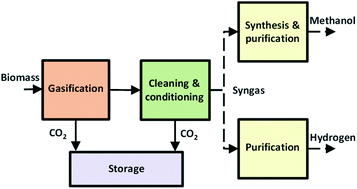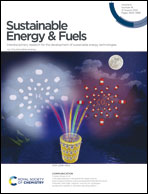Flexible methanol and hydrogen production from biomass gasification with negative emissions†
Abstract
Bioenergy plants with carbon capture and storage have been recently receiving attention as negative emission technologies. In this work, a techno-economic analysis of bio-methanol and bio-hydrogen production plants coupled with carbon capture and storage is conducted. The plants include different gasification technologies (direct oxygen-blown gasification and indirect gasification) and different CO2 capture processes (pre-combustion MDEA-based and post-combustion MEA-based CO2 capture) from different streams, to achieve increasing CO2 capture rates at increasing marginal costs. Moreover, an assessment of the economic impact of multi-product plants which flexibly produce methanol and hydrogen is carried out. Overall fuel production efficiencies of between 65.1 and 68.1% have been computed in all cases, showing a little dependency of energy efficiency on the gasification technology and the final product. In methanol production plants, a CO2 capture rate of between 26 and 55%, depending on the gasification technology, can be reached via a pre-combustion capture process at a cost of 41–46 € per tCO2. In hydrogen production plants, between 64 and 90% capture efficiency can be reached at a cost of 52–56 € per tCO2. Higher CO2 capture efficiency, resulting in CO2 residual emissions below 2% of the inlet carbon, can be achieved via post-combustion capture with a marginal cost of 98–205 € per tCO2 and an average cost of 47–77 € per tCO2. Flexible methanol-H2 production plants result in the highest capex and the highest LCOF. However, when considering the time-dependent H2 market price, the internal rate of return of flexible methanol-H2 plants is slightly higher or slightly lower than that of the corresponding best single-product plant. On the other hand, multi-product flexible plants are never the worst case scenario despite the highest investment costs, thus offering a potential advantage from the financial risk perspective thanks to lower exposure to market price volatility.



 Please wait while we load your content...
Please wait while we load your content...